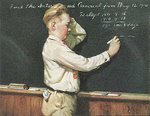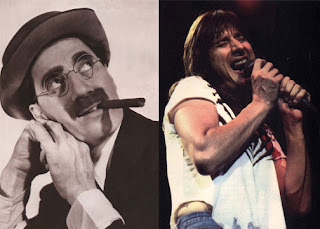In my youth, whenever I attended large concerts (particularly outdoor concerts), it was very likely I would hear someone in the crowd yell "Free Bird!" to the musicians onstage as a customary gesture of audience participation. I don't suspect that the person ever expected that Tom Petty or Pearl Jam or Skid Row (yes, yes, I know) would take them up on their suggestion of live material--although I'm sure the entire crowd would erupt in impish euphoria if they did, celebrating their victory of agency in a situation where they are generally expected to simply react. Still, yelling out the song name was a ritual at these concerts. There was even a specific voice the shouter enacted, that of the hippy-dippy stoner from the Freedom Rock record commercials from the late eighties ("Free Bird" is even included on the record!):
Many see the act of yelling "Free Bird!" a concert an act of heckling. For example, upon my suggestion that someone in my group should yell out the song title at a Bad Company/Damn Yankees concert, a fellow concert goer reprimanded me, noting that yelling "Free Bird!" is best left to those concerts where the band sucks. (Again, I was at a Bad Company/Damn Yankees concert.) Me, I'm not so sure about the heckling bit. Yes, the musicians most likely are sick of hearing the half-hearted request lobbed at them, and the luster of the irony and mischief has worn off. Still, there's something to be said about the audience member who wants to do more than simply react to the band, but instead hopes to drive the action, or perhaps even cause it to detour ever so slightly. They recognize the custom as fitting for the milieu, building off of the good feeling everyone is achieving, and although the contribution is not original, if timed well, it can still be a contribution. And rituals like these, once they become convention, can give birth to ideas that play off of or augment the original. It might be downright funny to yell, "Play some other Lynrd Skynrd song--anything but Free Bird!" or "Free Bert! Ernie's got him locked up!" Or maybe even slightly less lame suggestions.

Bert and the stool pigeon that got him locked up. No
truth to the rumor that the pigeon is the "Free Bird"
that inspired Ronny Van Zant to take pen in hand.
truth to the rumor that the pigeon is the "Free Bird"
that inspired Ronny Van Zant to take pen in hand.
And what does this act of concert crowd etiquette have to do with blogs? Only this (that I can see): Bloggers, no matter how selfish we may feel, must consider our readers (even if they are only imagined or, Blog gods forbid, imaginary). Blogging is a public act of writing and to do so just for the satisfaction of the self is a ludicrous, and (as mentioned last week) improbable venture. Musicians wouldn't tour if they didn't think their music can touch people. It shouldn't be any surprise that the people want to touch back. Every concert goer is a potential showman, to varying degrees, just like every reader of our blogs is a potential writer of her own. When we give a blogging concert and are fortunate to have an audience show up to "listen," we cannot expect only rhythmic dancing, swaying, and lip-syncing to our ideas. There will be some people who will want to discuss the lyrics or disparage the song or introduce us to new tunes. And, yes, there are gonna be some "Free Bird!" yellers out there.
Just promise me this: should you cave in and (metaphorically, of course) play "Free Bird," please-oh-please don't play the seventeen-minute version.










